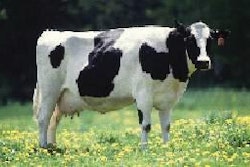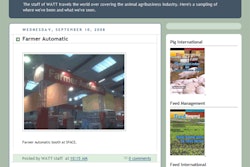Feed Management magazine set out to preview ingredients, equipment and services available at the International Feed Expo taking place Jan. 24-26, in Atlanta, with a focus on formulation and technology for 'Safe Feed/Safe Food.' Nearly 50 companies were invited to discuss their products and services for production of safe, quality feed at the lowest possible cost. The responses that follow provided some of the best explanations of how products, processes or services achieved the goals of 'Safe Feed/Safe Food.' Feed Management appreciates all those who took the time to respond to our query.
Safe Feed/Safe Food Certification Program
The Safe Feed/Safe Food Certification Program was launched by the American Feed Industry Association over two years ago to "demonstrate and ensure continuous improvement in the delivery of a safe and wholesome feed supply for the growth and care of animals."
Avoiding impairment of farm-produced or purchased feeds is crucial for efficient and profitable livestock management and sound animal production. Appropriate storage, transport and mixing operations are key to ensuring consistent quality makes its way in front of the livestock.
The program is geared toward helping companies to more visibly demonstrate their commitment to food safety, with an eye toward enhancing consumer confidence in their products. Participating companies include feed manufacturers, pet food manufacturers, ingredient suppliers, integrated producers, meat processors, feed purchasers, livestock producers and others who want to validate a commitment to food safety and proactive leadership. Companies meeting the program's requirements may use the SF/SF seal on their labeling and packaging. For more information or to download the guide, go to http://www.afia.org/Safe_Feed_Safe_Food.html.
Technology enhances quality measures
Alltech, Lexington, Ky., reports that they are furthering their commitment to providing consistent, premium products by developing the Alltech Quality System (AQS). The system is designed to help Alltech consolidate their Quality Assurance systems to meet regulatory requirements around the world. "By operating in 85 countries, Alltech is bound by many quality certifications," said Becky Timmons, Alltech Director of Applications Research & Quality Assurance. "AQS ensures that we are meeting AFIA Safe Feed/Safe Food, FCI RUPP, ISO 9001:2000 & 2200, and FAMI-QS standards and puts them under the Alltech quality umbrella."
The plan was nearly two years in the making and allows any of the 14 Alltech production sites and 70 warehouse locations around the world to apply for the certification that is applicable in that country. Each production facility implements the guidelines locally and Alltech is currently training regional teams to oversee the implementation of the program.
APEC, Lake Odessa, Mich., specializes in ingredient automation so most of its products are geared toward making feed and/or food products either safer or less expensive, says company spokesperson Terry Stemler. "By automatically dosing the ingredients that go into a recipe, we can make sure that the correct amount of ingredient is being added. We also limit the exposure that an operator has to those ingredients." One of the new features that APEC has incorporated into its micro ingredient scales is bar code confirmation of ingredients. Before a bag of material can be loaded into a hopper, the bag is scanned and then a lock on the lid of the ingredient hopper that contains the same ingredient opens. This ensures that the right ingredient gets in the right bin. Another feature that enhances the safety of APEC's feed is the lot tracking capability that is built into its batching automation. "This makes sure that each lot is tracked from receiving to packaging, so that if in the future the material needs to be traced, the lot can be easily called up and tracked from the beginning to the end of the manufacturing process," explains Stemler.
Feed Management Systems (FMS), Brooklyn Center, Minn., develops integrated software solutions to address issues faced by feed companies, including feed safety. In 2005, FMS identified the need for an automatic, comprehensive solution to food safety and compliance issues and launched a rigorous research and development process resulting in the development of FMS Feed Tags. This product allows clients to check medication levels and combinations in new formulas prior to releasing it for production, and automatically updates compendium data to ensure that manufacturers are using the most current information published in the Federal Register or the Medicating Ingredient Brochures. Feed Tags includes the ability to generate a feed tag on a demand basis and archive it, track levels used with each revision of a product, and utilize bar codes to enhance trace functionality.
The new HotBus Digital Serial Communication System from 4B Components, Ltd., East Peoria, Ill., is marketed to offer customers a much simpler and more cost effective approach to continuous bearing temperature monitoring. It features up to 256 bearing sensors on a single twisted pair cable, geared toward making installation much easier and maintenance-free. The system allows complete control with user-adjustable relative ambient and absolute trip points for each sensor. HotBus Control Units can be stand-alone or connected to relay control units to provide automatic machine shutdown. Ethernet, Modbus, and Device Net Gateways are also available for connection to existing networks. Software is provided for system test, system status and uploading of meaningful sensor names and logging/trending bearing temperatures and alarms.
Joe Zitek, Marketing Manager, InterSystems, Omaha, Neb., reports that his company has introduced a new line of self-cleaning conveyors to accommodate the ever-increasing demand for positive cleanout, especially when a variety of commodities are handled. "We call it the Kleen-Drag because of its design and cleanout abilities," he explains. The company reports that special attention was given to the design of the conveyors where intermediate discharges were required and "pockets" of material could not be tolerated. According to the company's website, some of the equipment's features include a self-cleaning bottom for superior cleanout, totally enclosed structure for clean plant operation, ability to convey large capacities in a compact space, conveying inclines up to 60 degrees, bend (knee) sections up to 60 degrees, and a wide variety of liners which are quickly replaceable.
LignoTech USA, Inc., Rothschild, Wis., responded with information on its main feed products, including Ameri-Bond 2X, a pelleting aid. Pelleting is recognized as a production method which results in hygienic effects in the processing of complete feed and production of mixed feed. The company states that the product has the ability to distribute well in the feed, absorb onto feed particles, become adhesive at the right time andupon dryingform bonds or bridges between molecules of feed particles. The product is claimed to provide consistency, along with high quality and no drug and mineral interaction.
.jpg?auto=format%2Ccompress&crop=faces&fit=crop&h=48&q=70&w=48)




.jpg?auto=format%2Ccompress&fit=crop&h=167&q=70&w=250)











